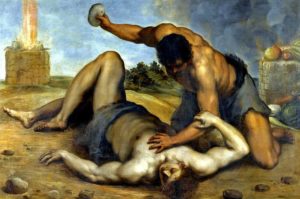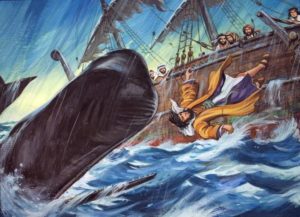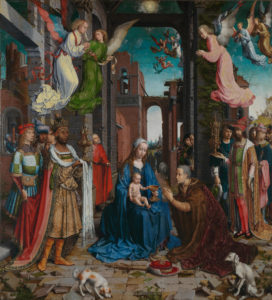Nov
17
A (Not So) Easy Bible Story Quiz
I have a fun one for you this week….
There have been many parts of the Bible’s historical narratives that have become well-known Bible stories. (Whether or not one accepts them as actual history is another issue.) Certainly, people who have been followers of Jesus for a number of years are familiar with these stories, even if they just remember them from children’s Sunday School. But, I’m sure there are many non-believers who are familiar with a few of these stories, too.
So, I put together a few quick questions regarding some popular Bible stories. See how many you get right…
1) What was the “forbidden fruit” that got Adam and Eve in trouble in the Garden of Eden?
Answer: I’m willing to bet that most people respond with “apple”,… but they would be wrong. Truth is, the Bible never names the type of fruit specifically. It refers to “the tree” in the middle of the garden (i.e., the tree of the knowledge of good and evil (Gen. 2:9,17; 3:1-17)) and the fruit simply as “the fruit” of said tree.
Besides an apple, some have speculated that the fruit may have been something like a fig, date-plum, pomegranate, or other fruit which can be found growing in the general region. Some Jewish commentaries have even suggested grapes, a citron, carob pods, wheat, or corn, though they don’t all grow on trees and some aren’t usually considered fruits proper. But, these types of vegetation are identified by name elsewhere in the Bible. The tree in question, however, seems to be a unique one that God planted in the garden — as opposed to, say, a “special” apple tree — and most likely had a unique fruit, as well.
So, where did the “apple” tradition come from? It is most popular in the West, and one theory is a strong similarity between the Latin words for ‘apple’ and ‘evil’. Another refers to a generic use of “apple” to mean any non-berry fruit. Yet another assumes the influence of, or conflation with, the Greek myth of the Golden Apples of the Hesperides in the Garden of the Hesperides. Whatever the origin, the idea was only strengthened by use of an apple in many paintings, storybook drawings, kids’ videos, Sunday School flannel-graphs, etc.
 2) How did Cain kill his brother Abel?
2) How did Cain kill his brother Abel?
Answer: We don’t know. Gen. 4:8 says, “… And while they were in the field, Cain attacked his brother Abel and killed him.” (HCSB) When confronting Cain a couple verses later, God says, “… Your brother’s blood cries out to Me from the ground! So now you are cursed, alienated, from the ground that opened its mouth to receive your brother’s blood you have shed.” Given the primitivity of the situation at the time, the method and possible weaponry would have been rather simple. The mention of blood could be figurative, though most available methods would have involved bloodshed.
A common assumption is that Cain bashed Abel in the head with a large rock. As with the apple, I think this has been promulgated over the years via paintings, storybook drawings, kids’ videos, Sunday School flannel-graphs, etc. But, he may very well have used an animal bone or a heavy stick or tree branch to club him. (Indeed, I have seen paintings depicting this, too.) Or, perhaps he pushed or tripped Abel, causing him to fall into a deep ravine and possibly break his neck. He may have stabbed him with a pointy stick or bone. Cain may have even used a sharpened stone that Abel used in preparing his sacrifices. (“Poetic justice” in his eyes?) Maybe he just used his hands to strangle or beat Abel to death. In the end, it doesn’t matter. Murder is murder.
 3) Where did Noah’s Ark come to rest after the Flood?
3) Where did Noah’s Ark come to rest after the Flood?
Answer: The reflex answer is “Mt. Ararat!”. But, technically, this is incorrect. Gen. 8:4 actually says, “The ark came to rest in the seventh month, on the seventeenth day of the month, on the mountains of Ararat.” Notice that the word “mountains” (<heharim>, which could also be translated “hills”) is plural. Obviously, even a vessel as large as the Ark can’t rest on more than one mountaintop simultaneously, though more than one “hill” is certainly possible. The point is that the Bible does not specifically identify the peak known even today as “Mount Ararat”. Rather, it is indicating a mountainous region or hill country.
Mount Ararat itself — actually the two volcanic cones of Lesser Ararat and Greater Ararat — is located in the Eastern Anatolia Region of Turkey, near borders with Iran, Armenia, and Azerbaijan, between the Aras and Murat rivers. However, the Armenians lay some claim to Ararat and the Ark, as well. Indeed, the “mountains of Ararat” probably included a large area of hills and mountains in that area of present-day Turkey and Armenia. Despite controversial claims of the Ark’s remains found on Mount Ararat, we don’t have indisputable proof of the Ark’s final resting place.
 4) Was Jonah swallowed by a whale?
4) Was Jonah swallowed by a whale?
It’s possible, but — children’s stories aside — we really don’t know. According to Jonah 1:17, “Now the Lord had appointed a huge fish to swallow Jonah, and Jonah was in the fish three days and three nights.” (HCSB) I checked over a dozen more translations, and they all use “fish”, with the exception of the ISV, which has “sea creature”.
Interestingly, the Hebrew word for “fish” in Jonah, <dag>, is not used on Creation Day 5 (Gen. 1:20-23). But, it is used in Day 6, when God is granting mankind dominion over “the fish of the sea”, etc. If Jonah was swallowed by a whale, the word <tannin> (as used in Gen. 1:21 and Job 7:12) seems more appropriate, as it is commonly translated “sea creature”, “sea monster”, or simply “sea animal”. (On the other hand, it is sometimes used for a serpent (Exod 7:9), crocodile (Ezek 29:3), or other powerful animal (Jer 51:34).) On the plus side, fin whales and sperm whales can indeed be found in the Mediterranean Sea.
While a whale is a possibility, I think it was more probably a large fish (not a sea mammal) that swallowed Jonah. No miracles of creation, mutation, or transportation are hinted at here. However, God did make sure that a fish of sufficient size was in the right place at the right time. Therefore, I’m going to guess that it was a “normal” fish that was native to the Mediterranean Sea. The giant grouper and goliath grouper are big enough (8-9 ft.), but they don’t — and, as far as I can tell, didn’t — venture into the Mediterranean. There are several shark species that live in the Mediterranean, including the Great White. The whale shark was my favorite candidate for awhile, since it is a huge-mouthed, filter-feeding carpet shark that commonly grows to 30-39 ft. in length (with reports of specimens up to 59 feet). But, then I noticed that it doesn’t migrate into the Mediterranean. (Maybe it did 2800 years ago?) My current favorite is the basking shark, which only reaches 20-26 ft. in length and is also a huge-mouthed, filter-feeding carpet shark. (Thus, no danger to humans.) And, yes, it is known to range into the Mediterranean.
5) Did God turn King Nebuchadnezzar into an animal/beast?
Simply put, no. I have seen speculation (or assumption) that prideful ol’ Neb actually became a cow, or possibly a goat. But, that just doesn’t fit the narrative in Daniel 4:
“31 While the words were still in the king’s mouth, a voice came from heaven: “King Nebuchadnezzar, to you it is declared that the kingdom has departed from you. 32 You will be driven away from people to live with the wild animals, and you will feed on grass like cattle for seven periods of time, until you acknowledge that the Most High is ruler over the kingdom of men, and He gives it to anyone He wants.” 33 At that moment the sentence against Nebuchadnezzar was executed. He was driven away from people. He ate grass like cattle, and his body was drenched with dew from the sky, until his hair grew like eagles’ feathers and his nails like birds’ claws. 34 But at the end of those days, I, Nebuchadnezzar, looked up to heaven, and my sanity returned to me….” (HCSB)
Clearly, God affected the king’s memory, reasoning ability, and behavior, such that he was ostracized from society (though probably watched over by the prince regent and others). It says that Nebuchadnezzar lived with wild animals — probably outside, thus the “drenched with dew” — and grazed like cattle. His hair and nails went untrimmed for the full 7 years, such that they looked like eagles’ feathers and like birds’ claws, respectively. In short, he went a bit insane and may have run around the countryside barely clothed, if at all. But, nothing says that God actually transformed the king into a wild animal.
6) How many kings or “Wise Men”/Magi visited the baby (or, more likely, toddler) Jesus?
I’m afraid that, if you said “three”, you have fallen for the same incorrect assumption that characterizes centuries of paintings, storybooks, dioramas, films & TV programs, etc. (Granted, some such representations may be for the purpose of simplification rather than due to ignorance.) The reason is because the kings/magi presented three valuable gifts to Jesus and his family: gold, frankincense, and myrrh. It is natural for us to picture in our mind’s eye one king/magus presenting each type of gift. The image has been reinforced over the years both within and outside the Church, so we just accept it.
If you read the applicable passage (Matt. 2:1-12), you won’t find any mention of how many kings/magi there were. There may have been only three. But, it is quite likely that there were more, plus an entourage of servants/assistants and guards with them, since they were wealthy and the journey was long and went through potentially hostile territory. It also says nothing of their names, yet since the 7th century they have been identified (and sainted by Roman Catholics) as Caspar, Melchior, and Balthazar. (I remember them from The Little Drummer Boy TV special!)
So much for another Christmas tradition… 🙂
 7) What happened when Saul was blinded by the light on the road to Damascus?
7) What happened when Saul was blinded by the light on the road to Damascus?
Did you say/think “He fell off his horse?” If so, I’d like to know where it says that in Scripture. The initial account (as related by Luke in Acts 9) says,
“3 As he traveled and was nearing Damascus, a light from heaven suddenly flashed around him. 4 Falling to the ground, he heard a voice saying to him, “Saul, Saul, why are you persecuting Me?” 5 “Who are You, Lord?” he said. “I am Jesus, the One you are persecuting,” He replied. 6 “But get up and go into the city, and you will be told what you must do.” 7 The men who were traveling with him stood speechless, hearing the sound but seeing no one. 8 Then Saul got up from the ground, and though his eyes were open, he could see nothing. So they took him by the hand and led him into Damascus. 9 He was unable to see for three days and did not eat or drink.”
Notice that there is no mention of falling off a horse, only falling to the ground. Nor is there the remounting of a horse, only getting up from the ground and being led by hand to Damascus.
When Paul himself relates the account to his Jewish unbelieving brethren in defense of his ministry (Acts 22), the relevant portions read:
“6 “As I was traveling and near Damascus, about noon an intense light from heaven suddenly flashed around me. 7 I fell to the ground and heard a voice….
11 “Since I couldn’t see because of the brightness of that light, I was led by the hand by those who were with me, and came into Damascus….” (HCSB)
And again, from Paul’s account before King Agrippa, Festus, and Bernice (Acts 26):
“12 “I was traveling to Damascus under these circumstances with authority and a commission from the chief priests. 13 King Agrippa, while on the road at midday, I saw a light from heaven brighter than the sun, shining around me and those traveling with me. 14 We all fell to the ground, and I heard a voice speaking to me in the Hebrew language, ‘Saul, Saul, why are you persecuting Me? It is hard for you to kick against the goads.’ 15 “Then I said, ‘Who are You, Lord?’ “And the Lord replied: ‘I am Jesus, the One you are persecuting. 16 But get up and stand on your feet. For I have appeared to you for this purpose,….”
Still no mention of any horses — just falling to the ground and standing back up. Yet, I’d be willing to bet that you’ve seen (as I have) artistic representations of Saul’s conversion that put him (and maybe some of those with him) on a horse. Again, it’s a possibility, but we have no evidence for the presence of horses in this incident.
These mistaken concepts that so many of us have might fall under the “Folk Theology” label I wrote about a few weeks ago. There are probably other instances of similar things that I just didn’t think of, too. In some cases, skeptics and anti-theists will likely try to make more out of them than they really warrant, though none of them really have any significant effect on doctrines. All it really means is that Christians are just as guilty as anyone of occasionally misreading texts, making assumptions, and of being socialized to accept certain traditions over the facts, because we often don’t check those facts out for ourselves.
Yep, we’re only human.


















